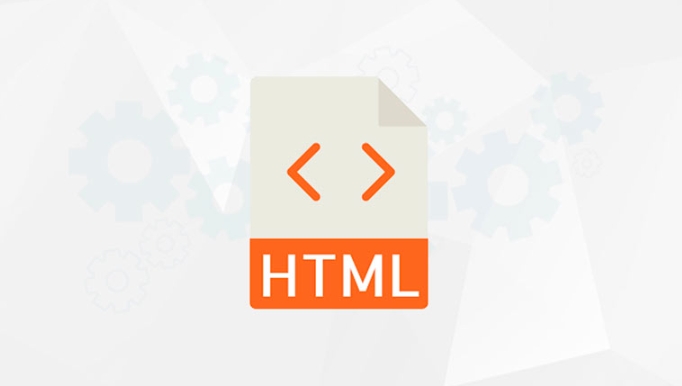<keygen> is a deprecated tag in HTML that is used to generate key pairs in forms for secure verification. 1. The function of <keygen> is to allow the browser to generate public and private keys, which are often used for client certificate generation; 2. Its common attributes include name, challenge, keytype, etc., to control the key generation behavior; 3. The reason for the deprecation is that modern browsers gradually abandon support and have a more flexible Web Crypto API to replace it; 4. For old system maintenance, it is recommended to record dependencies, gradually migrate to modern encryption solutions, and mark their deprecated status in the document.

In web development, some HTML elements are outdated, understanding their purpose and background can still help understand the logic of some old systems. The <keygen></keygen> tag is one of them.

It was originally used to generate key pairs in forms, and is often used for secure verification processes when users register, such as the generation of client certificates. Although it has been deprecated now (and modern browsers are gradually no longer supported), it is worth knowing when maintaining old systems or learning historical security mechanisms.
1. What is <keygen></keygen> ?
The purpose of the <keygen></keygen> tag is to allow the browser to generate a public and private key pair, which is usually used in conjunction with the server side for authentication. It has been widely used in scenarios where client certificates are required, such as internal enterprise login, SSL client authentication, etc.

This element appears in the form, and when the user submits the form, the browser sends the public key to the server, and the private key is saved on the user's local device.
For example:

<form method="post" action="/register"> <input type="text" name="username"> <keygen name="pubkey"> <input type="submit" value="Register"> </form>
In this example, when a user submits a form, in addition to the user name, the generated public key information will also be brought with him.
2. Common properties and uses
Although <keygen> is used relatively simple, it supports several key properties to control key generation behavior:
-
name: Must be set to identify the data received by this field on the server side. -
challenge: A string that will be included in the certificate request for server verification. -
keytype: Specifies the generated key type, common values includersa,dsa,ec, etc. -
autofocusanddisabled: Standard Boolean properties, control focus and disabled state.
For example:
<keygen name="user_key" challenge="abc123" keytype="rsa">
In this way, the browser will include "abc123" into the certificate request when generating the key, so that the server can perform subsequent processing.
3. Why is it not recommended to use now?
With the development of web technology, more modern and flexible security mechanisms have gradually replaced the functions of <keygen></keygen> :
- The Web Crypto API provides more powerful and controllable encryption capabilities, and developers can operate key generation, signature and encryption directly in JavaScript.
- Browser manufacturers are gradually abandoning support for
<keygen></keygen>, Chrome has removed the tag in earlier versions, and Firefox is also reducing support for related features. - User experience issues: Many users are not familiar with key management and certificate operations, which can easily cause confusion.
If you are building a new project, it is recommended to use JavaScript encryption schemes or to generate tokens on the server, such as JWT or OAuth processes.
4. What if the old system is still being maintained?
If you take over an old project and use <keygen></keygen> in it, you don't have to worry too much. It will still work properly for a while as long as the browser has not fully cleared the support.
However, it is recommended that you:
- Record the dependencies of existing functions to avoid compatibility issues caused by blind upgrades.
- Consider gradually moving to modern encryption solutions, such as replacing the original logic through the Web Crypto API.
- Mark the use of
<keygen></keygen>in the document and indicate its deprecated status to facilitate identification by subsequent maintenance personnel.
Basically that's it. Although <keygen></keygen> is no longer commonly used, as part of history, understanding its role and limitations is also helpful for understanding the evolution of front-end security mechanisms.
The above is the detailed content of HTML `keygen` Element (Deprecated but good to know). For more information, please follow other related articles on the PHP Chinese website!

Hot AI Tools

Undress AI Tool
Undress images for free

Undresser.AI Undress
AI-powered app for creating realistic nude photos

AI Clothes Remover
Online AI tool for removing clothes from photos.

Clothoff.io
AI clothes remover

Video Face Swap
Swap faces in any video effortlessly with our completely free AI face swap tool!

Hot Article

Hot Tools

Notepad++7.3.1
Easy-to-use and free code editor

SublimeText3 Chinese version
Chinese version, very easy to use

Zend Studio 13.0.1
Powerful PHP integrated development environment

Dreamweaver CS6
Visual web development tools

SublimeText3 Mac version
God-level code editing software (SublimeText3)
 Configuring Document Metadata Within the HTML head Element
Jul 09, 2025 am 02:30 AM
Configuring Document Metadata Within the HTML head Element
Jul 09, 2025 am 02:30 AM
Metadata in HTMLhead is crucial for SEO, social sharing, and browser behavior. 1. Set the page title and description, use and keep it concise and unique; 2. Add OpenGraph and Twitter card information to optimize social sharing effects, pay attention to the image size and use debugging tools to test; 3. Define the character set and viewport settings to ensure multi-language support is adapted to the mobile terminal; 4. Optional tags such as author copyright, robots control and canonical prevent duplicate content should also be configured reasonably.
 Best HTML tutorial for beginners in 2025
Jul 08, 2025 am 12:25 AM
Best HTML tutorial for beginners in 2025
Jul 08, 2025 am 12:25 AM
TolearnHTMLin2025,chooseatutorialthatbalanceshands-onpracticewithmodernstandardsandintegratesCSSandJavaScriptbasics.1.Prioritizehands-onlearningwithstep-by-stepprojectslikebuildingapersonalprofileorbloglayout.2.EnsureitcoversmodernHTMLelementssuchas,
 HTML for email templates tutorial
Jul 10, 2025 pm 02:01 PM
HTML for email templates tutorial
Jul 10, 2025 pm 02:01 PM
How to make HTML mail templates with good compatibility? First, you need to build a structure with tables to avoid using div flex or grid layout; secondly, all styles must be inlined and cannot rely on external CSS; then the picture should be added with alt description and use a public URL, and the buttons should be simulated with a table or td with background color; finally, you must test and adjust the details on multiple clients.
 How to handle forms submission in HTML without a server?
Jul 09, 2025 am 01:14 AM
How to handle forms submission in HTML without a server?
Jul 09, 2025 am 01:14 AM
When there is no backend server, HTML form submission can still be processed through front-end technology or third-party services. Specific methods include: 1. Use JavaScript to intercept form submissions to achieve input verification and user feedback, but the data will not be persisted; 2. Use third-party serverless form services such as Formspree to collect data and provide email notification and redirection functions; 3. Use localStorage to store temporary client data, which is suitable for saving user preferences or managing single-page application status, but is not suitable for long-term storage of sensitive information.
 What are the most commonly used global attributes in html?
Jul 10, 2025 am 10:58 AM
What are the most commonly used global attributes in html?
Jul 10, 2025 am 10:58 AM
class, id, style, data-, and title are the most commonly used global attributes in HTML. class is used to specify one or more class names to facilitate style setting and JavaScript operations; id provides unique identifiers for elements, suitable for anchor jumps and JavaScript control; style allows for inline styles to be added, suitable for temporary debugging but not recommended for large-scale use; data-properties are used to store custom data, which is convenient for front-end and back-end interaction; title is used to add mouseover prompts, but its style and behavior are limited by the browser. Reasonable selection of these attributes can improve development efficiency and user experience.
 Implementing Native Lazy Loading for Images in HTML
Jul 12, 2025 am 12:48 AM
Implementing Native Lazy Loading for Images in HTML
Jul 12, 2025 am 12:48 AM
Native lazy loading is a built-in browser function that enables lazy loading of pictures by adding loading="lazy" attribute to the tag. 1. It does not require JavaScript or third-party libraries, and is used directly in HTML; 2. It is suitable for pictures that are not displayed on the first screen below the page, picture gallery scrolling add-ons and large picture resources; 3. It is not suitable for pictures with first screen or display:none; 4. When using it, a suitable placeholder should be set to avoid layout jitter; 5. It should optimize responsive image loading in combination with srcset and sizes attributes; 6. Compatibility issues need to be considered. Some old browsers do not support it. They can be used through feature detection and combined with JavaScript solutions.
 How to add a video as a background in HTML?
Jul 08, 2025 am 12:03 AM
How to add a video as a background in HTML?
Jul 08, 2025 am 12:03 AM
To add a video background to a web page, the key is to use HTML tags correctly and optimize relevant attributes. 1. Use tags as background and use CSS positioning to fill the page or local area; 2. The video format is preferred.mp4, and WebM is added to consider compatibility; 3. Add muted and playsinline attributes to ensure automatic playback on the mobile side; 4. Control the video size to optimize the loading speed, and it is recommended to keep it at tens of MB; 5. Add loops to achieve seamless loop playback; 6. It can be flexibly applied to full screen or local blocks, and different effects are achieved by adjusting the container size and positioning method. The above steps can achieve a stable and beautiful video background.
 How to make a responsive iframe?
Jul 09, 2025 am 01:39 AM
How to make a responsive iframe?
Jul 09, 2025 am 01:39 AM
To make iframes responsive, the core is to use CSS to control the aspect ratio and combine it with the wrapping container to achieve adaptation. 1. Use padding techniques to create container boxes with fixed proportions. Common ratios such as 16:9 correspond to padding-top56.25%, 4:3 correspond to 75%, and 1:1 correspond to 100%; 2. Set the iframe width to 100% and use absolute positioning to fill the container, or use the aspect-ratio attribute to maintain the proportion; 3. When processing third-party embedded content, control the ratio through container wrapping, and ensure that the allowfullscreen attribute is added to support full-screen playback on mobile terminals. Master the container and proportion settings to realize the responsiveness of the iframe






